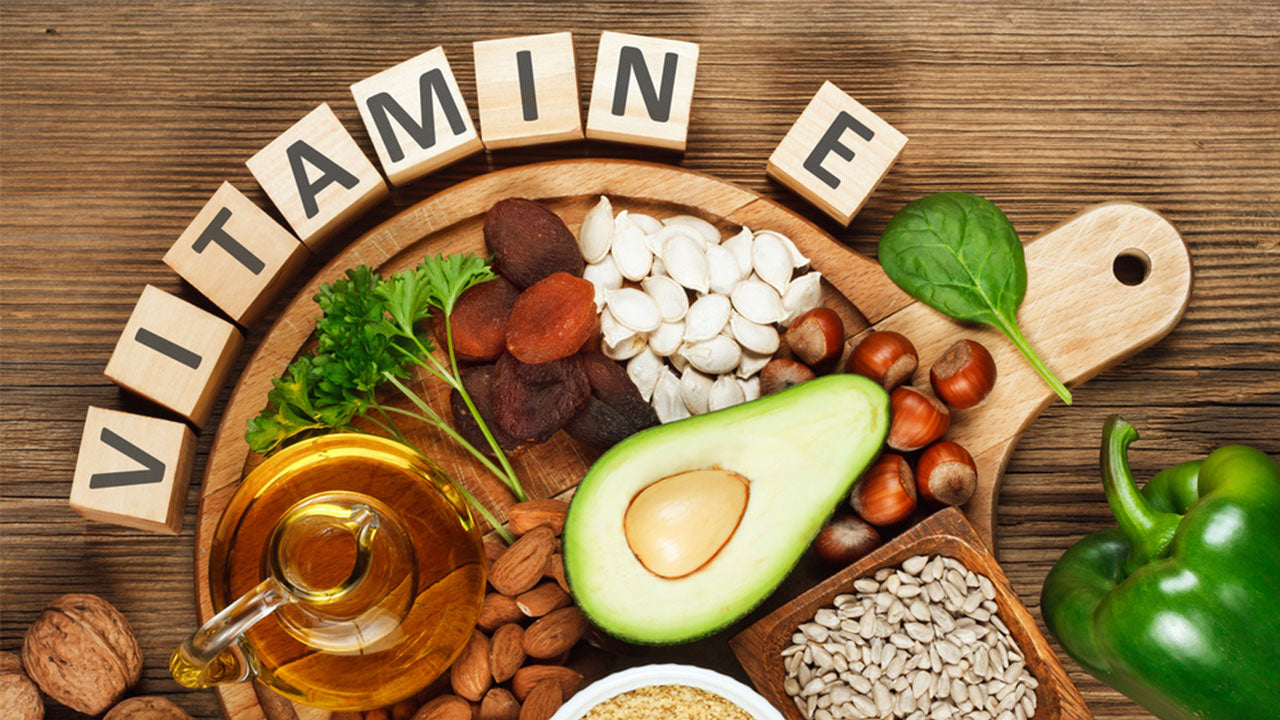Vitamin E for Fatty Liver Disease: Can It Really Help?
 By: by Amino Science
By: by Amino Science

Fatty liver disease is one of the most pervasive health problems in the world. It's also the most common chronic liver disease in the United States, where it's estimated to affect as many as a quarter to a third of the population. And as modern ills such as elevated cholesterol, obesity, and type 2 diabetes continue to climb, so, too, do rates of fatty liver. With numbers this dire, researchers are constantly searching for new ways to stem the ballooning tide of cases. And one method that's recently received a lot of attention is vitamin E therapy. But does it really work? In this article, we're going to take a closer look at vitamin E for fatty liver, sift through the evidence, and uncover everything you need to know about this possible new treatment for fatty liver disease.
What Causes Fatty Liver Disease?
Everything that goes into our bodies, whether it's eaten, inhaled, drunk, or touched, is processed by the liver. In the case of food, one of the liver's functions is to convert some of the protein and carbohydrates we eat into triglycerides.
Triglycerides are then broken down into free fatty acids and glycerol to be used as energy or moved to the adipose tissue for conversion into fat. Any triglycerides that are left over are then stored in the liver.
Under normal circumstances, the liver holds on to only a marginal amount of triglycerides. However, many of the health problems we associate with modern life, such as insulin resistance, metabolic syndrome, diabetes, elevated blood pressure and cholesterol, and even excessive alcohol use, can damage the liver's ability to metabolize fat. When this happens, fat begins to accumulate in the liver.
Although the liver is a remarkably resilient organ, if liver function is compromised to the point where more than 5% to 10% of its total volume is taken over by fat buildup, hepatic steatosis, or fatty liver, is the result.
More Than One Type of Fatty Liver
When it comes to fatty liver, there are several different types, but by far the most common is nonalcoholic fatty liver disease, or NAFLD. Affecting at least a quarter of the American population, NAFLD is the most common type of chronic liver disease.
While an individual may live with nonalcoholic fatty liver disease their entire lives and never experience any signs of liver damage, the condition can sometimes progress to nonalcoholic steatohepatitis, or NASH, which is characterized by the presence of both inflammation and damage to liver cells. If lifestyle interventions aren't instituted, NASH can eventually lead to serious complications, including liver cancer.
Less common than nonalcoholic fatty liver disease is alcoholic fatty liver disease. As the name suggests, this type of liver disease is the result of years of extensive alcohol abuse. Like NAFLD, alcoholic fatty liver disease can be stopped, and even reversed, by making simple lifestyle modifications—namely, stopping alcohol use.
Amazingly, giving up alcohol for even 2 weeks may be enough to boost liver function. However, like NAFLD, failure to address a fatty liver caused by alcohol use can lead to disease progression and eventual cirrhosis and liver failure.
Are You at Risk of Fatty Liver Disease?
If you eat the typical Western diet or are a heavy alcohol user, then, yes, you're definitely at risk of fatty liver disease.
And if you're overweight or leading a sedentary lifestyle, you, too, are at risk.
However, without liver testing to look for elevated levels of liver enzymes—including alanine transaminase (ALT) and aspartate transaminase (AST), which are sometimes called alanine aminotransferase and aspartate aminotransferase, respectively—you may never know.
And even with testing, your liver enzyme levels will likely remain in the normal range until inflammation has progressed to the point where your liver begins releasing these enzymes in response.
And because your liver is, again, so resilient, this may not happen even after cirrhosis has begun to set in.
But you don't want to wait until then to find out the worst.
So, in lieu of a liver biopsy to confirm a diagnosis—or obvious symptoms of fatty liver disease, including weight loss, itching, enlarged blood vessels, abdominal pain, and jaundice—the best thing to do, especially if you have known risk factors, is to change your lifestyle such that you're supporting your liver instead of working against it.

Treating Fatty Liver Disease with Diet
The foundation upon which successful treatment of nonalcoholic fatty liver disease—and alcoholic liver disease—is based is a healthy diet.
After all, it's a Western diet high in simple sugars, salt, saturated fat, red meat, and processed foods and low in fresh fruits, vegetables, whole grains, lean protein, and healthy fats that set us up for fatty liver in the first place.
Not only is the standard Western diet almost completely devoid of actual nutrition, it's also a breeding ground of pro-oxidant molecules called free radicals. Like everything else in nature, these unstable atoms with unpaired electrons seek equilibrium. But to find it, they must roam around the body, stealing electrons from other atoms. However, in so doing, they only succeed in creating more free radicals.
Over time, this can lead to a state of oxidative stress, in which cells are damaged and tissues and organs begin to fail. In fact, a number of diseases, from heart disease and diabetes to cataracts and cancer, are linked to oxidative stress.
Thankfully, the body has a natural ability to produce its own antioxidants. However, unlike diets that emphasize fruits and vegetables—which are rich sources of antioxidants, including beta-carotene, vitamin C, and a host of beneficial phytochemicals—nutrient-poor Western diets do nothing but add to the body's free radical burden.
And that brings us to one antioxidant in particular, and the main topic of this article.
Vitamin E for Fatty Liver Disease
Vitamin E is a fat-soluble antioxidant that's gained notoriety in recent years for its potential efficacy in the treatment of NAFLD and NASH.
In fact, numerous studies have found a possible link between vitamin E supplementation and improvement in liver function.
One of the most well known is a clinical trial known as the PIVENS study. Performed by researchers including Arun Sanyal and Anna Diehl and published in the New England Journal of Medicine in 2010, this randomized controlled trial evaluated the effects of treatment with the anti-diabetic medication pioglitazone, vitamin E, or placebo in NASH patients with aggressive disease progression who had not been diagnosed with diabetes.
Interestingly, although both pioglitazone (30 milligrams a day) and vitamin E (800 International Units a day, in the form of d-alpha tocopherol) were superior to placebo in improving symptoms of NASH—including liver enzyme levels, signs of inflammation, and hepatic steatosis—the improvements seen with pioglitazone were not considered statistically significant.
However, vitamin E treatment was. In fact, it led to significant improvements, outperforming pioglitazone by a wide margin.
A 2014 meta-analysis published in the journal Nutrition not only backed up these findings but also found that the use of vitamin E was effective in lowering liver enzyme levels in patients diagnosed with both nonalcoholic fatty liver disease and chronic hepatitis C.
And a more recent 2018 review published in the journal Diseases determined that the antioxidant and anti-inflammatory properties of vitamin E, combined with its ability to inhibit cell death—as well as its favorable clinical profile—make it an effective choice for the treatment of non-diabetic NASH patients who have failed treatment with lifestyle modifications.
As you can see, the potential effect of vitamin E on fatty liver disease shows definite promise. But nature's got one more thing up her sleeve in the fight against this rising epidemic.
Amino Acids for Fatty Liver Disease
While you may know them as simply the building blocks of protein, amino acids play an important role in the proper functioning of nearly every single biological process in the human body—including liver function.
In fact, multiple studies have found that amino acids may offer significant benefits for individuals suffering from fatty liver disease.
A 2012 rodent study published in the journal Nutrition Research demonstrated the ability of the branched-chain amino acids (BCAAs) leucine, isoleucine, and valine to reduce liver cell death, formation of scar tissue, and progression of chronic liver disease.
Similarly, a 2018 study published in the journal Amino Acids found that taurine is effective at reducing both oxidative stress and fatty acid accumulation in mice fed high-fat diets.
The supplemental form of the amino acid cysteine, N-acetylcysteine (NAC), is especially well known for its liver benefits. In fact, NAC is regularly used in hospitals in the treatment of acetaminophen overdose.
What makes it so effective?
It turns out that N-acetylcysteine is particularly good at replenishing glutathione—the body's master antioxidant. More glutathione means less oxidative stress, which in turn means less cellular damage.
The compound S-adenosylmethionine (SAMe), which is made up of the amino acid methionine and a molecule of adenosine triphosphate (ATP)—the body's main energy carrier—is also known to protect the liver by reducing the accumulation of fat and the associated rise in liver enzyme levels and scar tissue formation.

Preventing Chronic Liver Disease
From heart disease and diabetes to strokes and colon cancer, more and more diseases have become pervasive in the more affluent countries of the West. And the one thing they all have in common is that they're almost entirely preventable.
Fatty liver disease is no different.
With simple lifestyle interventions, including healthy diet, exercise, decreased alcohol use, vitamin E, and amino acids, fatty liver disease can be prevented or reversed long before it turns into chronic liver disease.
So if you have any known risk factors and need help planning your next move, don't hesitate to seek the advice of a qualified health care professional. After all, you only have one liver...treat it well.

Up to 25% off Amino
Shop NowTAGS: conditions liver natural cures
Join the Community
Comments (0)
Most Craveable Recipes




 833-264-6620
833-264-6620



















